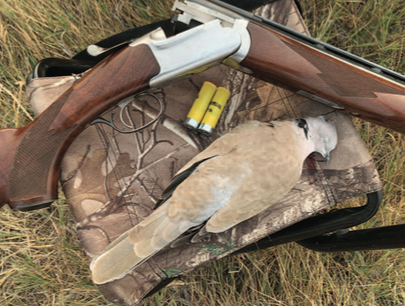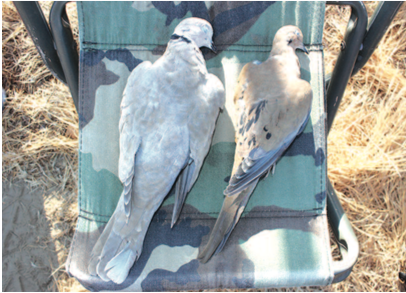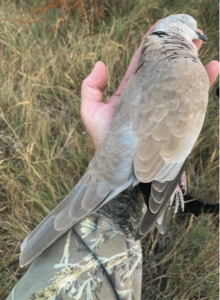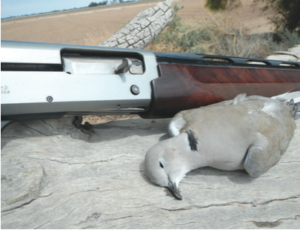
It goes without saying that if hunters want to hunt in the summer months, their options are limited here in California. With the exception of cottontail rabbit, which opened on July 1, no other game species has an open season during the summertime. Rifle hunters can turn to wild pig or coyotes, but wing shooters either have to break out the clay pigeons or just sit and wait until the dove opener on September 1. Fortunately, that all changed a little over five years ago with the arrival of the exotic Eurasian dove.
Records show that sometime in the 1970s the Eurasian or collared dove was accidently released in the Bahamas. From there, they started showing up in Florida in the mid 1980s. Less than 20 years later they showed up in California, with the first report being documented by a dove hunter in 2001.
Species that are not native to the state are considered non-native or exotic species. In most cases, the California Department of Fish and Wildlife acknowledges their presence and leaves it at that. However, when there appears to be a hunting interest with these new arrivals, the Department will monitor their progress and act accordingly.

TIM E. HOVEY PHOTO
Since their initial invasion into the state in 2001, the Eurasian dove has steadily moved throughout California. Their success at adapting to human-influenced landscapes like roads and parks, made the decision by Fish and Wildlife to open them up to hunters in 2014 an easy one.
The opening up of an additional huntable species doesn’t happen often here in California. The added benefit of targeting exotic species is that since they are considered non-native invaders, they typically have no closed season nor bag limit. Due to their recent, unplanned arrival, the California Department of Fish and Wildlife moved forward in 2014 and opened up Eurasian dove with a year-round season and unlimited take.
If you’ve hunted mourning dove over the last few years, chances are you’ve seen Eurasians mixed in with the smaller migratory bird. They are usually 50% larger than mourning dove and lighter in color. Owing to their other common name, they possess a dark band or collar located at the back of the neck, thus the collared dove.

Research has shown that their amazing coast-to-coast invasion has come due to their ability to thrive in and around human habitation. Every year I see more and more of the larger dove in neighborhood settings. It’s clear that to successfully reproduce and thrive in California, they’ve found everything they need wherever humans have populated.
As far as hunting them, they tend to stick close to farms and agricultural fields, and they like to roost in dead trees. In my experience, they fly throughout the day from roosting and feeding areas, to water and back. The same gear you would use for mourning dove is suited perfectly for chasing Eurasians. Much like their smaller cousins, they have amazing vision, so camo clothing and concealment can help you out tremendously.
Despite being a larger bird, I’d stick with the smaller dove loads in the 7.5 and 8 shot size. They have a similar vocalization or coo sound as the mourning dove and I have had some success at mimicking their call back to them and bringing them in closer.
They appear to respond to the Mojo decoys that many dove hunters use now. However,

I’ve only seen a handful commit to the decoys, but they certainly come in to investigate. Over the years, I’ve seen Eurasians mixed in with groups of mourning dove and flying in pairs. In fact, when we see two birds coming in, more often than not the approaching pair are of the larger collared variety.
The breasts of the Eurasian dove are larger and the meat tastes identical to the mourning dove meat. It cooks the same and can be added to any popular dove popper recipe without skipping a beat. And with no limit or season, you now can enjoy the unique popper flavor year-round.
Every invasion has a starting point, and the first records of the non-native dove were in the southern portion of the state near Imperial Valley. Subsequently, their arrival to the north is somewhat recent and their numbers certainly reflect that. A higher number of Eurasian dove are present in the southern portion of the state rather than parts farther north. However, we have seen a steady increase in their numbers in the central portion of the state where we hunt mourning dove.
Today’s hunters are presented with a unique opportunity to hunt a species that only recently invaded California. This does not happen very often without an additional cost from the state. You still need a hunting license to pursue Eurasian dove, and a recent check of the Fish and Wildlife regulations stated that you also need an upland bird stamp, which I find puzzling. However, chances are, if you’re looking to add an additional species to your hunting list, you already have a bird stamp on your license.
If you’re looking to do some additional wing shooting during the summer months, head out to your favorite mourning dove spot and take a look around. Set up a Mojo dove decoy, sit in the shade and see what drops in. The added bonus of getting to pursue a non-native species all year round is that you can do some early season scouting for the mourning dove opener on September 1.



